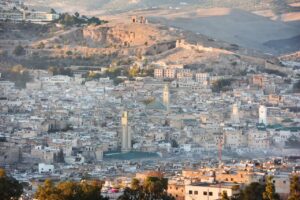Nestled within the bustling heart of the Fez Medina, the Al-Attarine Madrasa stands as one of the most exquisite examples of Moroccan architecture and craftsmanship. Built during the Marinid dynasty, this historical monument continues to captivate visitors with its intricate details and serene atmosphere, offering a glimpse into the rich educational and cultural heritage of medieval Fez.
Historical Background
Commissioned by Sultan Abu Sa’id Uthman II, the Al-Attarine Madrasa was completed in 1325. Named after the nearby spice and perfume market, or “Souk al-Attarine,” this madrasa served as both a school and a residence for students of the Islamic sciences. It was one of several madrasas built by the Marinid rulers to promote religious education and scholarly pursuits, cementing Fez’s reputation as a center of learning in the Islamic world.
Architectural Splendor
The Al-Attarine Madrasa is renowned for its stunning architecture, which embodies the finest elements of Marinid design. As you enter through the grand wooden door, you are greeted by a tranquil courtyard adorned with a marble fountain, surrounded by intricately carved cedar wood panels, stucco, and zellij tilework in vibrant geometric patterns.
- The Courtyard: The madrasa’s central courtyard is a masterpiece of Islamic art. Its white marble and green-tiled floors reflect the sunlight, creating a warm, inviting space. The intricate zellij tiles—small, hand-cut pieces of mosaic—cover the walls with geometric and floral patterns, showcasing the skill of Moroccan artisans.
- The Prayer Hall: Beyond the courtyard lies the prayer hall, a small but exquisitely decorated space. The mihrab, or prayer niche, is framed by ornate stucco and cedar wood carvings, drawing the eye to its delicate craftsmanship. Light filters through the hall from intricately designed windows, casting beautiful patterns on the walls and floor.
- The Upper Floors: Originally used as student dormitories, the upper floors are lined with small rooms where students once lived and studied. While simple in design, these quarters offer a contrasting glimpse into the daily lives of the madrasa’s scholars.
Symbolism and Artistic Details
The decoration of the Al-Attarine Madrasa is rich with symbolic meaning. The use of water in the courtyard fountain represents purity and knowledge, essential elements of the Islamic faith. The intricate patterns of the zellij tiles and carved stucco are not merely decorative; they reflect the Islamic emphasis on unity, order, and the infinite nature of God.
The cedar wood, sourced from the nearby Middle Atlas Mountains, adds a fragrant, earthy quality to the madrasa. Its detailed carvings depict floral and geometric patterns, meticulously crafted by artisans who spent years perfecting their art.
Visiting the Al-Attarine Madrasa
- Opening Hours: The madrasa is open to visitors daily, typically from 9:00 AM to 5:00 PM, although hours may vary during religious holidays.
- Admission: A small entrance fee is required, which contributes to the preservation of this historic site.
- Tips for Visitors: To fully appreciate the intricate details, take your time to explore the courtyard and prayer hall, and don’t forget to look up—the ceilings are often just as ornate as the walls.
- Respectful Visiting: As with all religious sites, visitors should dress modestly, covering shoulders and knees. Photography is usually allowed, but it’s best to be mindful of the setting.
Preserving a Legacy
The Al-Attarine Madrasa is more than just a historical monument; it is a testament to the cultural and educational legacy of Fez. Efforts to preserve its delicate architecture and artistry are ongoing, ensuring that future generations can continue to marvel at its beauty.
For anyone visiting Fez, the Al-Attarine Madrasa is a must-see, offering not only a visual feast of Moroccan craftsmanship but also a profound connection to the city’s rich academic and spiritual history.




